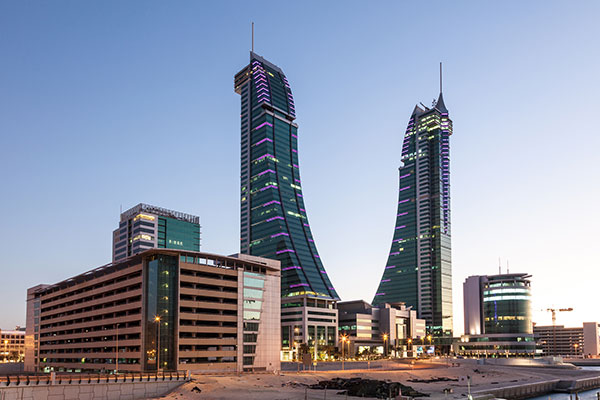
Bahrain’s non-oil growth is expected to average 4.6 per cent over 2018-19, underpinned by government infrastructure spending on a record $8 billion worth of projects—the kingdom’s largest ever pipeline, said the National Bank of Kuwait (NBK) in its latest Economic Update.
Capital spending spans a variety of projects in transportation, water and power, and housing sectors, the report added.
Thanks to continued output gains in the non-oil sector, real GDP growth accelerated in 2017 to 3.9 per cent from 3.2 per cent in 2016.
The services sector—financial and social & personal services especially—and the construction sectors were major contributors to the non-oil sector’s impressive growth of 5.0 per cent last year, the highest in the GCC.
Such spending has been bolstered over the past few quarters by the allocation of funds under the Gulf Development Program—a pledge by Bahrain’s neighbours in 2011 to provide $10 billion in grants over 10 years to boost investment in infrastructure and housing.
Burgeoning non-oil activity also helped offset some of the contraction in the oil sector due to the Opec+ production cut agreement, in which Bahrain is a participant. Oil sector output is expected to fall slightly in 2018 as Bahrain adheres to its Opec+ quota obligations and as oil field output is affected by lingering maintenance issues.
However, the expected winding down of the production cut agreement from mid-2018 onward should allow Bahrain to ramp up to full output capacity, likely in 2019, boosting real oil GDP by 0.8 per cent.
The kingdom is also in the process of upgrading its oil infrastructure, including the ageing oil pipeline from Saudi Arabia and the expansion of the Sitra refinery that will see refining capacity increased by almost 50 percent. The latter is expected to boost state revenues by about $1 billion, according to official sources.
Moreover, in April, Bahrain announced that it had discovered up to 80 billion barrels of shale oil and around 20 trillion cu ft of natural gas in offshore deposits. It hopes to monetize these new reserves within the next five years with the help of international oil companies.
To this end, the government recently launched an energy fund that aims to raise $1 billion from local and international investors. Monetizing these new energy resources could ultimately restore investor confidence and reduce the country’s fiscal deficit and high public debt levels—Bahrain is currently rated at below investment grade by major rating agencies S&P (B+), Moody’s (B1) and Fitch (BB-).
Inflation to rise in 2018 and in 2019
Consumer price inflation is expected to rise from 1.4 per cent in 2017 to 2.5 per cent this year and then further to 3.5 per cent in 2019 on the back of a planned value-added tax (VAT) and higher housing and food costs. Latest figures showed inflation averaging 2.8 per cent year-on-year (y/y) in 1Q18—higher than the 0.7 per cent y/y average recorded during the same period last year—after excise duties were levied on tobacco and soft drinks.
The introduction of a 5 per cent VAT, now expected in 2019, is projected to add initially around 2 per cent to the overall inflation rate.
Budget deficit to gradually narrow but remain high
The budget deficit is expected to gradually narrow, given ongoing fiscal consolidation efforts and some improvement in revenues. While the VAT should raise around $300 million (approximately 1 per cent of GDP) in additional tax revenue per year, the deficit will remain large at around 9.3 per cent and 7.6 per cent of GDP in 2018 and 2019, respectively.
The government will therefore have to continue to look to domestic and international bond markets to plug the shortfall. The latest issue came in March 2018, a 7-year $1 billion Sukuk at 6.875 per cent, higher than the 5.25 per cent on Sukuk issued in late 2017.
The hike in pricing reflects investors’ concerns over the fiscal position and rising debt (which is expected to top 100 per cent of GDP by 2019) as well as higher short-term rates.
Business lending remains in recovery mode
Growth in credit to businesses continued to climb in 1Q18, thanks to the ongoing gains in lending activity in the construction sector. This has helped push total private credit growth higher, averaging an impressive 9.7 per cent y/y in 1Q18, which is much higher than the 2.9 per cent y/y recorded in 1Q17.
In contrast, private sector deposits grew by 2.8 per cent y/y in 1Q18, higher than the 1.7 per cent y/y average of 1Q17. With deposit growth subdued, M1 and M2 declined in April by 4.0 per cent y/y and 1.4 per cent y/y respectively.
Following the US Fed’s move in June, Bahrain raised its key policy rate by 25 bps to 2.25 per cent. Interbank rates have been edging higher in tandem with the policy rate hikes over the past year. As of early June, the 3-month rate was up 49 bps year-to-date. While lending may come under pressure from higher rates, the business sector is expected to continue to support overall credit growth.
Foreign reserves remain under pressure
Given its large fiscal (and external deficits), Bahrain’s international reserves remain under pressure. In April, the central bank’s international reserves stood at $2.1 billion, covering a mere 1.8 months of imports.
Bahrain stock market weighed down by fiscal, debt concerns
After rallying briefly towards the end of 2017 and at the start of this year, Bahrain’s All Share Index moved lower in 2Q18, weighed down by fiscal and debt concerns. However, a more encouraging economic outlook and higher oil prices should offer the market some support going forward. – TradeArabia News Service
Send us your company’s news today and they could be featured on ABC’s Community News tommorow.